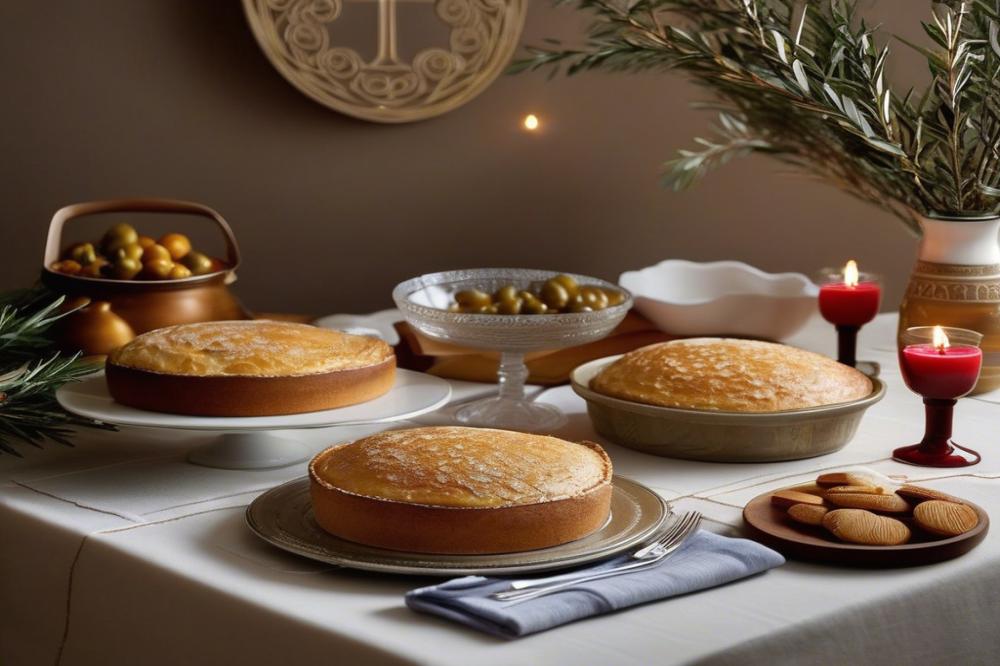Introduction
Fanouropita is a cherished Greek dessert, often associated with the feast of Saint Fanourios. This sweet pastry serves as a symbol of hope and remembrance. On this special day, many Greeks honor the saint, who is known for helping people find lost items and offering comfort in difficult times. Celebrated every August 27, Saint Fanourios Day brings together family and friends for a day filled with love and delicious treats.
Every year, families prepare this traditional Greek sweet to show admiration and reverence. The dish is particularly important during periods of fasting, as it is made with simple ingredients. A typical baking recipe includes flour, sugar, olive oil, and various spices. Each of these elements come together to create a delightful pastry, rich in flavor.
In Greek culture, food often plays a significant role in traditions. Recipes are passed down through generations, preserving customs and memories. The Fanouropita, with its unique taste and comforting aroma, evokes feelings of nostalgia and warmth. Many bakeries on the island and in communities around the world also prepare this delicacy, making it a staple on this day.
Learning how to make homemade fanouropita can be a rewarding experience. It not only connects one to their roots but also brings joy to loved ones during this festive occasion. With baking tips and an understanding of the fanouropita ingredients, anyone can create a special treat in honor of Saint Fanourios.
Understanding Fanouropita

Definition of Fanouropita
Fanouropita is a traditional Greek dessert often enjoyed during the Feast of Saint Fanourios. This delicious pastry typically features a sweet filling along with a lightly spiced flavor profile. Many bakers use a variety of fanouropita ingredients, including flour, sugar, and olive oil, to create its unique texture.
Its Role in Greek Dessert Tradition
In Greek culture, sweet pastries hold a special place during celebrations and religious observances. The fanouropita plays a significant role in the family gatherings that surround Saint Fanourios Day. As one of several traditional Greek sweets, it symbolizes community and sharing. Families often bake a homemade fanouropita to honor this important day, making it a favorite among many.
Origin and Stories Associated with Saint Fanourios
Saint Fanourios, the saint celebrated on August 27th, is known for his commitment to faith and devotion. He is often depicted with a loaf of bread, making the connection to this baking recipe clear. It is said that fans of the saint, in their quest for guidance, would bake this pastry, then offer it as a sign of gratitude. There are various stories about this saint, some directly connected to loss and recovery, reflecting themes of hope. Many believe that by sharing this pastry with others, they can seek blessings and fortune. Fasting recipes, including fanouropita, also make it suitable for those observing dietary restrictions.
Discovering the rich history of fanouropita makes the act of baking it even more meaningful. Whether you’re an experienced baker or trying this for the first time, following a few baking tips can elevate your experience. Enjoy the process of making a special pastry for Saint Fanourios.
Fanouropita Ingredients and Measurements

To bake a traditional Greek dessert for Saint Fanourios Day, start with the fanouropita ingredients. This pastry is cherished in Greek culture, and it symbolizes the search for lost items. Here’s a detailed list of what you need:
- 1 cup olive oil
- 1 cup sugar
- 3 cups all-purpose flour
- 1 cup orange juice
- 1 tablespoon baking powder
- 1 teaspoon baking soda
- 1 teaspoon ground cinnamon
- A pinch of salt
- Optional: nuts or sesame seeds for topping
Each ingredient plays a significant role in the recipe. For instance, olive oil adds moisture and richness. Sugar sweetens the pastry while providing a delightful crust. With 3 cups of all-purpose flour, you achieve the necessary structure. Orange juice adds a zesty flavor that balances the sweetness perfectly. Baking powder and baking soda contribute to the rise, creating a light texture. Ground cinnamon infuses warmth and an inviting aroma. Finally, a pinch of salt enhances all these flavors, making the dessert more complex.
Nutritional Information
Let’s break down the nutritional aspects:
- Olive Oil: High in healthy fats, about 120 calories per tablespoon.
- Sugar: Provides energy but has no essential nutrients, approximately 48 calories per teaspoon.
- All-Purpose Flour: A primary source of carbohydrates, around 100 calories per ¼ cup.
- Orange Juice: Packed with vitamin C, about 14 calories per tablespoon.
- Baking Powder and Baking Soda: Minimal calories, used for leavening.
- Cinnamon: Contains antioxidants, approximately 6 calories per teaspoon.
- Salt: No calories, used to enhance flavor.
- Nuts or Sesame Seeds: Rich in nutrients, approximately 150 calories per ounce.
This Greek dessert can indeed cater to various dietary needs. Specifically, fanouropita serves as an excellent fasting recipe, especially for those avoiding animal products. The ingredients are entirely plant-based, which aligns with many fasting traditions in the Greek Orthodox Church.
Baking Tips for Homemade Fanouropita
While preparing this tasty pastry for Saint Fanourios, consider a few essential baking tips. Sifting the flour before measuring helps achieve a lighter texture. Mixing the dry and wet ingredients separately aids in better distribution, leading to an even bake. When adding optional toppings like nuts or sesame seeds, sprinkle them on right before baking for a crunchy finish.
As you delve into this delightful baking recipe, remember to enjoy the process. Creating traditional Greek sweets like fanouropita not only honors Saint Fanourios but also connects you to generations of bakers. This recipe’s simplicity makes it accessible, yet it is steeped in culture and meaning.
Cooking Instructions

Step-by-step guide for baking Fanouropita
Begin by preheating your oven to 350°F (175°C). This is essential for achieving that perfect golden crust. While the oven warms up, gather your ingredients and prepare your workspace.
Next, mix the wet ingredients in a bowl. Combine orange juice, olive oil, and sugar until well blended. This mixture will add moisture and sweetness to the Greek dessert.
Then, focus on the dry ingredients. In another bowl, whisk together flour, baking powder, and a pinch of salt. This step is crucial to get an even texture in your pastry for Saint Fanourios.
Once both mixtures are ready, slowly blend the wet and dry ingredients. Stir gently until you achieve a smooth batter. Finally, pour this batter into a greased baking dish, ensuring it spreads evenly across the bottom.
The baking time will depend on your oven, but it typically takes about 30-40 minutes. Keep an eye on it! The fanouropita should become a beautiful golden color, and a toothpick inserted into the center should come out clean.
Tips for ensuring perfect texture and flavor
For the best result, let the dish sit for a few minutes after baking. This resting time helps the flavors settle and improves texture. Using fresh ingredients will also make a difference in taste; consider fresh lemon or orange juice if available.
Sprinkling powdered sugar on top before serving can elevate the dessert’s appearance and sweetness. Pairing it with a side of honey adds a delightful twist, honoring tradition.
Don’t hesitate to experiment with flavors. Adding chopped nuts or dried fruits can provide a unique touch, reflecting your taste during this special occasion. Following these baking tips will help you enjoy a delicious homemade fanouropita, celebrating Greek culture on Saint Fanourios Day.
Baking Tips for Homemade Fanouropita

Techniques for Beginners
Making this Greek dessert can seem overwhelming, but it’s quite manageable. Start by gathering all your ingredients first. Measure accurately for the best results. When mixing, stir gently to avoid overworking the dough. This will lead to a fluffier texture. Using parchment paper in the baking pan simplifies cleanup. Keep an eye on the oven as each appliance can vary. A toothpick inserted into the center of the pastry should come out clean when it’s fully baked.
Suggestions for Variations
Feel free to get creative! While traditional Greek sweets often focus on specific flavor profiles, there is room for experimentation. Adding spices can enhance the taste significantly. Think about incorporating cinnamon or nutmeg for a warm hint. You may also try mixing in ingredients like chopped nuts or dried fruits for increased flavor and texture. Honey can replace sugar for a naturally sweet twist. Don’t hesitate to swap out some of the fanouropita ingredients to make it your own.
Storage Tips for Keeping the Dessert Fresh
After the pastry cools, proper storage is necessary for maintaining freshness. Place it in an airtight container; this is crucial to prevent it from drying out. Alternatively, wrapping it tightly with plastic wrap works well, too. If you want to keep it for a longer time, consider freezing it. Just make sure to wrap portions individually. Thaw slowly in the refrigerator, and then enjoy your baked creation, still and tasty like the day you made it. Remember, marinating flavors in the fridge can add depth to this fasting recipe, making each piece even more delightful.
Cultural Significance of Fanouropita
Baking and sharing this traditional Greek dessert reflects deep-rooted customs. It connects families and communities through generations. In many households, making this particular pastry for Saint Fanourios becomes a cherished ritual. This simple, sweet treat showcases the rich flavors and baking techniques of Greece. While preparing it, many think of their ancestors and the stories passed down through time.
The offering of the pie on Saint Fanourios’ day holds deep significance. It symbolizes the hope for blessings and the search for lost items. Families prepare the pie as a form of prayer, asking for the intercession of Saint Fanourios. This act brings a sense of unity and reinforces the values of faith and charity among people. Sharing slices with friends and neighbors spreads joy and strengthens community ties.
Customs surrounding this day are steeped in tradition. Many observe fasting leading up to the celebration, making it a fasting recipe in nature. Commonly, people also prepare it without eggs or dairy to honor these practices. While baking, they gather as a family, sharing tips and anecdotes that make the process enjoyable. Celebrating with homemade fanouropita brings everyone together in a unique way.
Each district in Greece may have its own take on the pie, highlighting regional diversity. Different fanouropita ingredients might include nuts or spices, which add local flair. This allows each family to personalize their recipe based on taste preferences. The sweet aroma wafting from the oven stirs memories of previous celebrations and family gatherings. It reminds people of their ties to Greek culture and heritage.
Final Thoughts on Fanouropita
Recapping the significance of this delightful Greek dessert is essential. Fanouropita is not just a treat; it symbolizes hope and remembrance on Saint Fanourios Day. Traditionally, it is baked in honor of the saint, asking for his help and guidance. Communities gather, share stories, and enjoy this sweet delicacy, creating a sense of unity and shared faith.
Trying the baking recipe can become a cherished activity for you and your family. It’s an opportunity to carry on traditions while making unforgettable memories in the kitchen. Whether you are experienced or a novice baker, this recipe offers a simple yet rewarding challenge. Don’t hesitate to gather your loved ones around and bake something that connects generations.
In today’s world, traditional sweets still hold a place of joy. Incorporating recipes like this helps keep cultural practices alive while bridging gaps between the past and present. Enjoying these flavors in your home means sharing a piece of heritage with those you love. Celebrate with a slice of Fanouropita, and you’ll find that every bite is filled with history and warmth.



